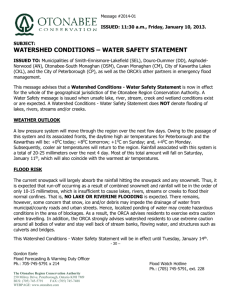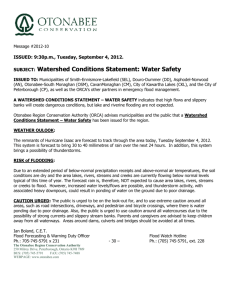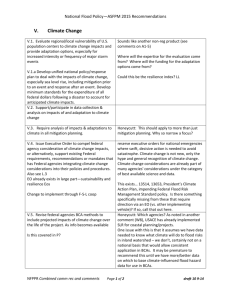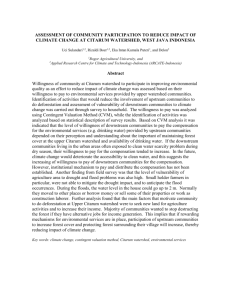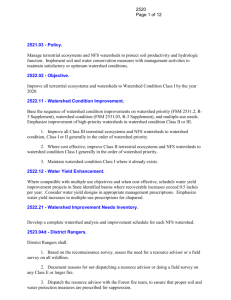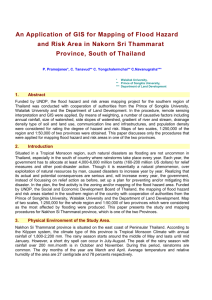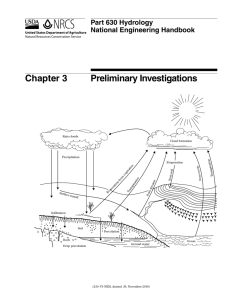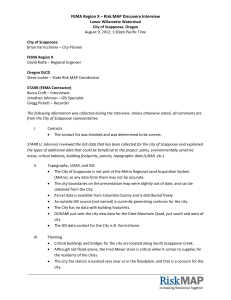Community Discovery Data Questionnaire
advertisement
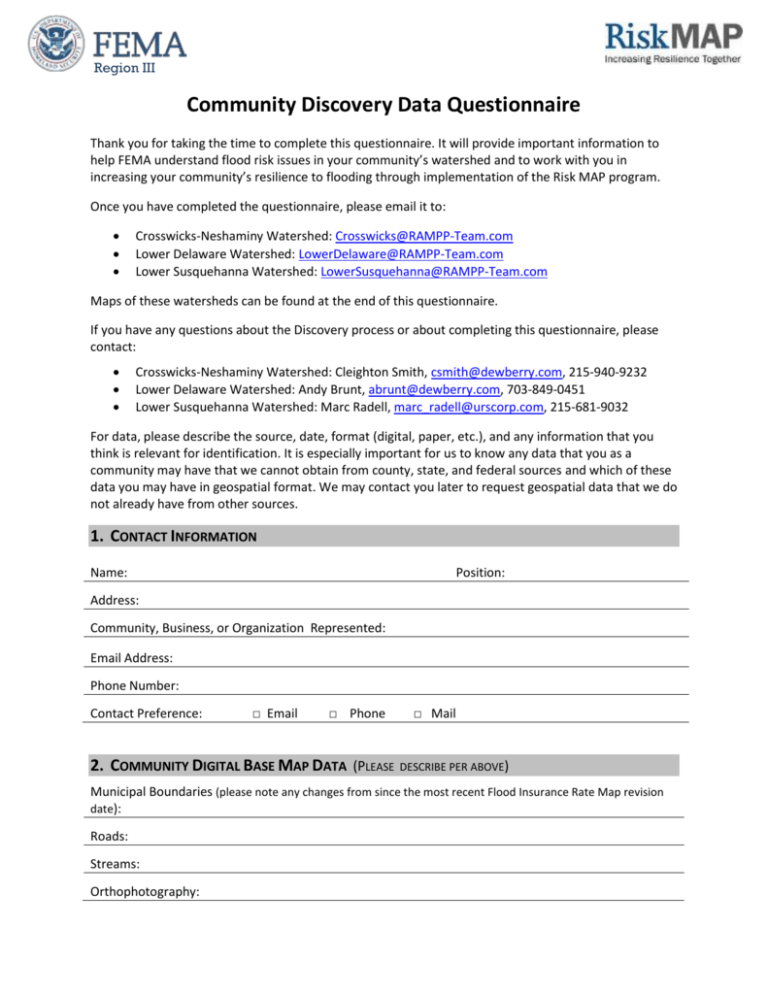
Region III Community Discovery Data Questionnaire Thank you for taking the time to complete this questionnaire. It will provide important information to help FEMA understand flood risk issues in your community’s watershed and to work with you in increasing your community’s resilience to flooding through implementation of the Risk MAP program. Once you have completed the questionnaire, please email it to: Crosswicks-Neshaminy Watershed: Crosswicks@RAMPP-Team.com Lower Delaware Watershed: LowerDelaware@RAMPP-Team.com Lower Susquehanna Watershed: LowerSusquehanna@RAMPP-Team.com Maps of these watersheds can be found at the end of this questionnaire. If you have any questions about the Discovery process or about completing this questionnaire, please contact: Crosswicks-Neshaminy Watershed: Cleighton Smith, csmith@dewberry.com, 215-940-9232 Lower Delaware Watershed: Andy Brunt, abrunt@dewberry.com, 703-849-0451 Lower Susquehanna Watershed: Marc Radell, marc_radell@urscorp.com, 215-681-9032 For data, please describe the source, date, format (digital, paper, etc.), and any information that you think is relevant for identification. It is especially important for us to know any data that you as a community may have that we cannot obtain from county, state, and federal sources and which of these data you may have in geospatial format. We may contact you later to request geospatial data that we do not already have from other sources. 1. CONTACT INFORMATION Name: Position: Address: Community, Business, or Organization Represented: Email Address: Phone Number: Contact Preference: □ Email □ Phone 2. COMMUNITY DIGITAL BASE MAP DATA (PLEASE □ Mail DESCRIBE PER ABOVE) Municipal Boundaries (please note any changes from since the most recent Flood Insurance Rate Map revision date): Roads: Streams: Orthophotography: Elevation/Topographic Data: Property Information (Assessor’s Data): Land Use and/ or Zoning Plan Maps: 3. ENGINEERING DATA (PLEASE DESCRIBE PER ABOVE) e.g., National Inventory of Dams (NID) information, local floodplain studies, as-built plans for new/modified structures (bridges, culverts, etc.) in the floodplain or retention areas; subdivision drainage plans; soils maps; . Identify any relevant reports or studies that include hydrology, hydraulics, survey or LiDAR. Please provide when the study was completed and the Point of Contact. 4. ENGINEERING DATA CONTINUED (PLEASE DESCRIBE PER ABOVE) e.g., Are there any naturally occurring underground streams within your community? Please describe the locations in detail with addresses or geospatial coordinates when possible. Are there any piped streams within your community? Please indicate the locations on the work map provided. 5. RISK ASSESSMENT DATA (PLEASE DESCRIBE PER ABOVE) e.g., Local risk assessment data, non-flood hazards, critical facilities, hazard mapping [ie. chemical depots, confinement facilities, dam-break inundation maps, sink holes, etc] 6. HAZARD MITIGATION PLANNING INFORMATION (PLEASE PROVIDE FOR REGIONAL, COUNTY, OR LOCAL) Name of existing plan: Plan date: Expiration date: Technical assistance that the community may desire to assist in hazard mitigation planning: 7. FLOOD MITIGATION ACTIVITIES INFORMATION (PLEASE DESCRIBE) e.g., Community Rating Service (CRS) participation, CRS activities, stormwater Best Management Practices, hazard mitigation grant projects, and other actionable projects. Please include Point of Contact. 8. RECENT, ONGOING, OR PROPOSED PROJECTS AFFECTING FLOOD HAZARDS (PLEASE DESCRIBE) e.g., Department of Transportation, Army Corps of Engineers, Natural Resources Conservation Service or other privately funded projects, including bridge and culvert replacements, since the most recent Flood Insurance Rate Map revision date. 9. RECENT DEVELOPMENT OR AREAS THAT ARE PLANNED FOR FUTURE DEVELOPMENT AND OTHER LAND USE INFORMATION (PLEASE DESCRIBE) e.g., For development since the latest Flood Insurance Rate Map revision date: What is the nature of the development? How large is the development? What is the number of structures in the floodplain? Did it involve a LOMA, LOMR, or LOMR-F? If so, please provide the case number. Please describe the locations in detail with addresses or geospatial coordinates when possible. Please also identify any local comprehensive and/or land use plans, regional watershed plans, sustainability plans, habitat conservation plans, coastal-related plans, etc 10. HISTORICAL FLOOD DATA (PLEASE DESCRIBE) e.g., news articles, high-water marks, mapped inundation areas, disaster declarations, stormwater issues, areas with known flooding issues, undersized culvert or bridge openings, etc. Please describe and provide Point of Contact. Also, are there areas that have flooded that are NOT shown on your maps as SFHA? If so, please provide us with the approximate location or attach a scanned map of the location. 11. NATIONAL FLOOD INSURANCE PROGRAM CHANGES (PLEASE DESCRIBE) e.g., Describe any recent Letters of Map Revisions, areas where LOMAs are concentrated, recent Community Assistance Visit results. 12. ANY ADDITIONAL COMMENTS REGARDING YOUR COMMUNITY’S FLOOD HAZARDS OR FLOOD MAPPING NEEDS?

